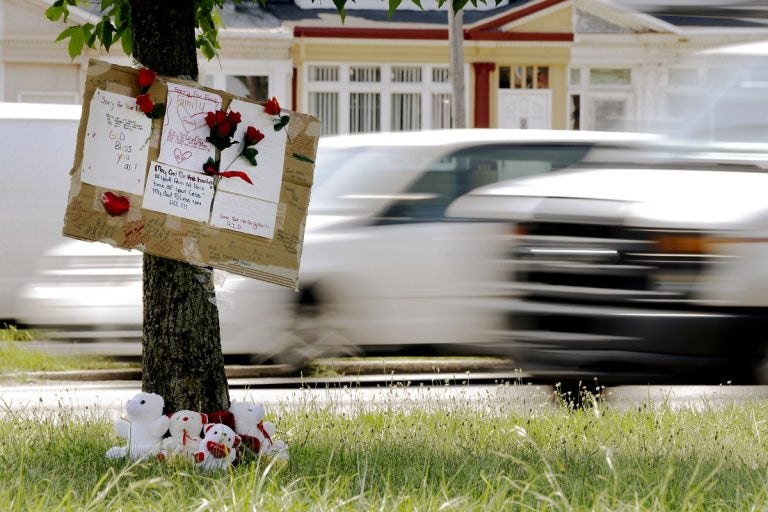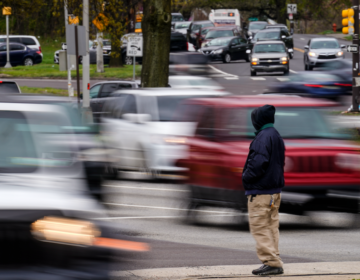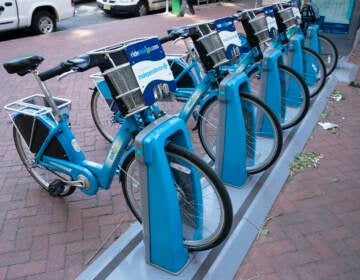City streets safer than suburban roads, study finds
New research from the University of Pennsylvania shows that denser cities and towns can save lives.

A makeshift memorial is shown near the location where a mother and three young sons were struck and killed while trying to cross a busy highway after dark, Wednesday, July 17, 2013 in Philadelphia. A fourth son was injured in the crash Tuesday night on Roosevelt Boulevard, a major artery that divides neighborhoods in north and northeast Philadelphia. (Matt Rourke/AP Photo)
This article originally appeared on PlanPhilly.
—
New research from the University of Pennsylvania shows that denser cities and towns can save lives.
The four-year-long study compared Pennsylvania Department of Transportation records of all car accidents in a five-county region with population data, socioeconomic factors, different road types, and other factors. The resulting analysis, which examined collision data from 2010 and 2014, showed that the densest parts of the region –– like downtown Philly or suburban town centers –– had lower accident rates than more sprawling areas.
“In general, at least in a relatively dense city like Philadelphia, you see traffic safety benefits coming with high density,” said Erick Guerra, co-author of the study and an assistant professor of urban planning at Penn.
Fewer roads and slower traffic speeds in Philly explain some of the difference in crash rates. The region’s densest census tracts house 28% of the Delaware Valley’s population, but just 6% of all roadways and far fewer high-speed boulevards or highways. Across the five-county region, roads with average speeds of 45 miles-per-hour witnessed 10 times more deaths on average than roads with 25 miles-per-hour speed limits, the study found.
But Guerra said those results come with a big caveat that may raise questions about traffic planning in suburban Bucks, Montgomery, Delaware and Chester counties.
In these areas generally designed to be traveled by car, roads weren’t equally safe for drivers and pedestrians. While denser sections of the suburbs had lower accident rates overall, drivers fared better than pedestrians. Densely populated areas in the suburbs and some outlying Philadelphia neighborhoods actually experienced higher rates of vehicle/pedestrian collisions than sparsely populated areas.
Guerra said the culprit in these areas is the type of road that replaced many older Main Streets: the multi-lane arterial “stroads” that aim to speed traffic through densely populated areas.
“A more conservative roadway is much safer. Smaller, fewer lanes, lower speeds,” he said. “A typical arterial is intended for higher volume and speed. You could imagine someone driving down parts of Broad Street going 40 or 50 miles per hour if the lights were going their way. You’re not doing that on Pine Street, downtown.”
He said this disparity represented a critical challenge for an older region dotted with both 19th-century towns and sprawling exurbs that have sought to densify in an effort to court younger generations attracted to communities with walkability and transit access.
“I think it can inform where we want to grow and why. It’s evidence that a more sprawling and exurban growth pattern is going to be more dangerous,” he said. “And it should show where we want to concentrate pedestrian-safety features.”
These latest findings join a chorus of similar national research about the impacts of traffic speeds, road design and density. Car crashes are one of the leading causes of death in the United States, according to the National Highway and Traffic Safety Administration, ranking in the top ten most common types of fatalities for all individuals aged from one to 64-years-old.
Guerra said Philadelphia shows better road safety trends than more auto-centric, sprawling places like Houston. But the city showed worse outcomes than some East Coast peers.
“New York City, D.C. or Boston, these are cities that have some similarities to Philadelphia and it makes you wonder what the difference is. I could speculate that it has to do with enforcement or driving behavior,” he said. “ But I think it’s an open and interesting question. If we could get our fatality from six per 100,000 to three per 100,000, that’s a lot of lives saved.
WHYY is your source for fact-based, in-depth journalism and information. As a nonprofit organization, we rely on financial support from readers like you. Please give today.







